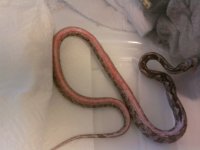In answer to "how?"
Two years ago I moved from VA to WA in June. When I got to WA, I didn't have anywhere to keep my snakes while I found a house and I when I finally found a place, there was no ambient heat. Even in June, the temps in WA are often 45 degrees in the mornings and in the shade, very rarely get over 60.
What you are looking at is the result of my attempt to use a 70 inch UVA/UVB bulb over the top of a bunch of the snakes to raise the temps in their tanks. They were like that for a few weeks when I noticed that my Lavendar's skin along her dorsal surface had "tanned" for lack of a better word. I brought her inside and took a picture of it to post here on the forum. Right after I got the pictures taken, I reached in to handle her and when I did, she jerked and the entire strip of skin along her back came off. I was horrified. She was twitching and jerking and the it looked awful. I took her and put her in a sterilite container with damp, white sterile rags and used Neosporin spray ointment to spray along her wound. The vet and I finally figured out what had happened and that it was due to the light and I got it off of my other snakes, but not before my poor blizzard had developed an angry red "pattern" and become dehydrated herself. I brought her in and put her in a sterilite container and after two sheds, she was fine. I waivered back and forth with putting the lavendar down, but she would show signs of improvement and I'd give her another day. I put her on a two pinkies every 3 days diet, and she ate them ravenously. The skin granulated and she shed her skin every 2 weeks or so until it was almost the way it is now. I documented pretty much the entire experience as it unfolded at the time.
None of my snakes have lights anymore. I keep the room they are in at 67 and I keep the humidity in there at around 30 percent or so. They have their undertank heaters and they have been happy, healthy snakes without any issues shedding or feeding since.
This was a hard lesson to learn. I've had snakes a long time, but always in FL or VA or MS and ambient temps have never been a problem.
I learned a lot from this though. #1-you HAVE to use the appropriate heating methods. #2-Lights are tools and the types of lights you use, if any, should be very species specific. #3-First aid for snake burns. I'm a nurse and former vet tech so I had some experience with burns in people and mammals, but this was horrific. I think I used my head and came up with a good treatment regimen. The vet was pretty impressed, he was inclined to put her down as well. Now we both know.


